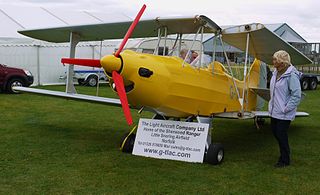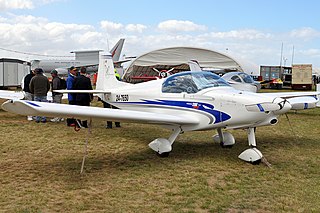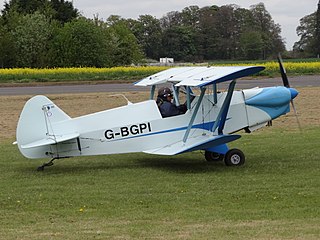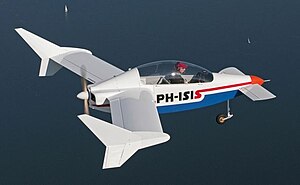
The Rutan Quickie is a lightweight single-seat taildragger aircraft of composite construction, configured with tandem wings.

The SAI-Ambrosini SS.4 was an Italian fighter prototype developed in the late 1930s, featuring a canard-style wing layout and a pusher propeller. Development of the SS.4 was abandoned after the prototype crashed on its second flight.

The Freedom Aviation Phoenix was a single-engine four-seat American airplane that was sold as a homebuilt composite canard aircraft.

The Rand Robinson KR-1 is a single-seat, single-engine sport aircraft designed in the United States in the early 1970s and marketed for homebuilding. A two-seat version is marketed as the KR-2. It is a low-wing cantilever monoplane of conventional design with an enclosed cockpit and tailwheel undercarriage. As originally designed, the main undercarriage units of the KR-1 and basic KR-2 were manually retractable, folding backwards into the wings, while the KR-2T tandem-seat version had fixed tricycle undercarriage. However, some builders choose fixed tailwheel or even fixed tricycle undercarriage for KR-1s and KR-2s.
The Kolb Kolbra and King Kolbra are a family of American tandem two seater, high wing, strut-braced, pusher configuration, conventional landing gear-equipped ultralight aircraft that are produced in kit form by New Kolb Aircraft of London, Kentucky and intended for amateur construction.
The Nike PUL 9 is an Argentine experimental tailless aircraft powered by a Rotax 447 engine.
The Ryson STP-1 Swallow is an American experimental two-seat powered cruising sailplane designed and built by the Ryson Aviation Corporation to be license built by other companies.
The Waspair HM 81 Tomcat is a British canard ultralight aircraft of unusual design, that was produced by Waspair and later Midwest Microlites. The designer is disputed and Chip Erwin, Larry Whiting and Robin Haynes are all named as designers. The aircraft was supplied as a kit for amateur construction.

The Tiger Cub Developments (TCD) Sherwood Ranger is a single engine, tandem two seat biplane microlight designed and built in the United Kingdom in the early 1990s. Kits were originally produced by TCD; later, design rights were acquired by The Light Aircraft Company Ltd (TLAC) who resumed kit production in 2009.

The Alpi Pioneer 200 is an Italian ultralight and light-sport aircraft, designed produced by Alpi Aviation, of Pordenone. The aircraft is supplied as a kit for amateur construction or as a complete ready-to-fly-aircraft.
The AV Leichtflugzeuge Vagabund is a German ultralight aircraft that was designed by Birk Meier, Hans Grannemann and Robert Kaps and produced by AV Leichtflugzeuge of Haren, Germany. The aircraft is supplied as a kit or plans for amateur construction or as a complete ready-to-fly-aircraft.

The Jodel D18 is a French ultralight aircraft, designed and produced by Jodel.
The JPM 03 Loiret is a French amateur-built aircraft that was designed by Jean-Pierre Marie and produced by Avions Jean-Pierre Marie (JPM) of Le Mesnil-Esnard. The aircraft is a development of the JPM 01 Médoc and is supplied as plans for amateur construction.

The Just SuperSTOL is an American STOL amateur-built aircraft, designed and produced by Just Aircraft of Walhalla, South Carolina. The aircraft is supplied as a kit for amateur construction.
The Farner HF Colibri 1 SL was an unusual canard motor glider with a unique control system, designed and built in Switzerland in the late 1970s. Only one was constructed; much modified during the 1980s, it was still flying in 1990.

The Gidroplan Che-22 Korvet is a three-seat, parasol wing flying boat designed and built in Russia from the 1990s. It can have one or two engines and may be configured as an amphibian. At least eighty have been produced.

The Fauvel AV.2 (AV for aile volante was the first Fauvel type to fly, completed in 1932.
The Parrish Dart is an American canard-configuration homebuilt aircraft that was designed by Jimmy R. Parrish and produced by Parrish Aircraft Xperimental, Inc. of Plantation, Florida, introduced in 1995. When it was available the aircraft was supplied in the form of plans for amateur construction.

The Plumb BGP-1 is a British single-seat homebuilt biplane developed by Barry Plumb.
The Henri Farman HF.35 was a large 3-seat biplane designed and built in France by Henri Farman during 1915.











